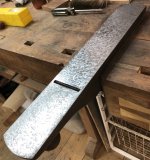Here's the original response to P. Sellers blog that got me thinking about plane dynamics again:
The statement WTTE of making a Stanley type perform as well as any other resonates with me because it is one i have often made myself. Mr Seller's post is a useful plea for common sense.
Nonetheless, regarding throat apertures his post disclaims a lot of history.
If you are a carpenter (Stanley bench planes et al as he describes were directed toward carpenters, though certainly to include high end joiners) and use softwoods, or typical mild joinery woods, throat aperture is nearly irrelevant.
I cannot substantiate pre-industrial efforts to narrow throats in planes, though many wooden soles are seen with repairs there including a piece of dense hardwood. One might imagine that was an occasional useful improvement going back to perhaps just after the days of Roman infills. However, since the advent of mass produced cast body (ca 1820's) and later fabricated metal plate planes, most of the good ones at some point in their design included a more or less quick option to adjust the throat aperture. This was true from approximately the late 1820's through the late 1920's.
A case can be made that before 1830 the Knowles patent and Savage planes included the option to close the throat by means of a back wedge. On clear factual grounds, Shelabarger's patent (1848) & Hopper's patent (1855) are early examples of user-makers who believed it worth the effort and that a need existed within the trade. From the 1850's on, the patents and manufactured examples of throat adjusters came thick and fast. In England, Stewart Spiers, and Norris among others, offered adjustable iron toe pieces for wooden sole planes. Perhaps based upon earlier examples from the former colonies, perhaps independent development by people of like minds. (Need) English makers of smoothing planes seem to have made a virtue of tight throats, though none was adjustable other than with shims or by means of iron thickness. OTOH, these were all double iron planes, so there was a conflict (see cap iron paragraph, further down).
There is a clear advantage for the use of a well tuned finely fit throat-to-iron gap in many situations. As a professional i can relate that when necessary, it saves time (by a large factor) and reduces risk (by a large factor). Even if you are a person who uses primarily abrasives for the semi-finish through finish stages, there are constructions and situations where the reduced risk to tear-out of a tight aperture throat might still be useful during the fitting, leveling, fettling stages of a construction.
All that said, a parallel viewpoint & practice concentrates on the cap-iron/iron fitting and dimensional relationship. Few ever really get good, or perhaps the better word is "rigorous" with attention to that detail. If that is a user/practitioner preference, the throat aperture (so long as the sole is flat and stable & iron rigidly bedded) almost does not matter. A tight throat and a perfectly set cap iron are mutually exclusive at the performance limit for either.
Personally, i prefer the option to have both, and build it into all my planes. Years ago i even included both in my adjustable pitch smoother.
Per your passing note re iron hardness: An iron need only be hard enough to resist folding the sharp edge at the preferred sharpness angle, in use. It should not be so hard as to be *chippy. Hardness and wear resistance are not directly related. Most wear on a plane iron is heat enhanced chemical erosion, not abrasion. These factors can be juggled (optimized) by choice of steel, and by the hardening schedule for each choice. Some steels allow a greater range of manipulation through hardening schedule, than do others.
*NB: IOW charpy values ("toughness") generally decline with increased hardness. However, for some steels, there is an inflection point by means of hardening schedule, where "you can (nearly) have it all." OTOH, since the choice of such steel is often for enhanced wear properties despite being softer, the ease of sharpening is often low.
smt








